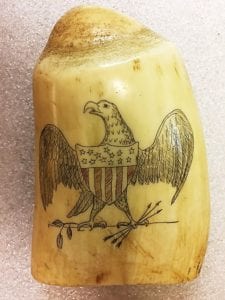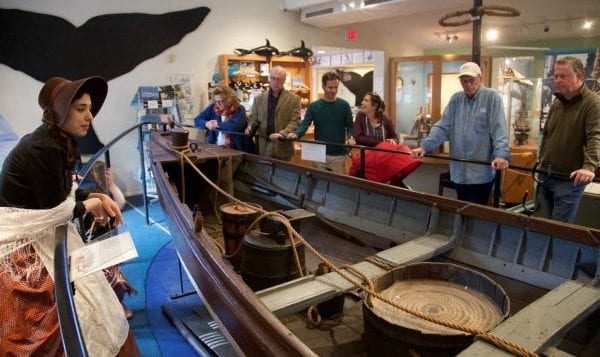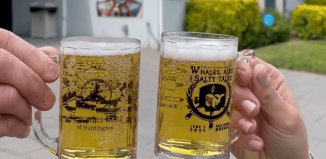Your Turn: Celebrating the Fourth of July — on a whaleship
By Nomi Dayan
While most people today visit The Whaling Museum while on vacation or during the weekend, there was no vacation or days off for a whaler. Work was paramount for whaling crews. However, a whaler might look forward to the three holidays for which there was a chance of observance while at sea: the Fourth of July, Thanksgiving, and Christmas (with Thanksgiving bring considered the most important holiday at the time).
Captains dictated if and how a holiday was observed. If there were instruments on board, nationalistic music was played and sung. Some crews engaged in whaleboat races for sport. If the captain was feeling generous, a special meal might be extended to even the lowest-ranking crew members. Culinary celebrations gave welcome respite from a monotonous and dreary diet of food that was often infested or spoiled. On a holiday, whalers might enjoy sea pies, a kind of pot pie that sometimes contained dolphin meat, or lobscouse, a stew of salted meat, onions and sea biscuits. Dessert might be mincemeat pie — which consisted of chopped meat, suet, raisins, apples and spices; dandyfunk, a baked mass of hard tack crackers and molasses; or duff, a boiled pudding.
Robert Weir aboard the Clara Bell journaled about a distinct feast on July 4th. He wrote how the crew fired salutes and enjoyed “coconuts, roast pig, minced pie, soft tack, ginger cake, pepper sauce, molasses, pepper, rice and pickles — quite extensive for a sailor.”
Aside from the chance of a special treat, July 4th — as with other holidays at sea — was likely to be a disappointment for those hoping for a break from work. Whaler William B. Whitecar Jr. recalled that when a crew member protested spinning yarn on the Fourth of July, the commanding mate’s answer was “Yes — it is fourth of July at home, but not here.”
Many logbooks, official records of daily activity on whaleships, do not document any festivities on this date, instead solely focusing on catching whales. The logbook of the Lafayette off the coast of Peru recorded July 4, 1843, only as an unfruitful day: “So ended this Fourth of July pursuing whales.”
Women who joined their captain-husbands at sea often noted the marked lack of observance of July 4th. Eliza Williams, who sailed with Captain Thomas Williams on the Florida from Massachusetts to the North Pacific and birthed two children during the voyage, wrote in her journal in 1859 in the Shantar Sea: “July 4th … some of the boats, it seems see aplenty of Whales, and once in a while are lucky enough to take one, but not often. Our boats lost two of their Men and that was not all … It doesn’t seem much like the Fourth of July, up here.”

A few years later in 1861, she recorded: “July 4th. Today is Independence. Oh how I would like to be at home and enjoy this day with family and friends. We cannot celebrate it here with any degree of pleasure. Just after dinner, we spoke the bark Monmouth [Cold Spring Harbor ship], Capt. Ormsby … He reported the loss of the clipper ship Polar Star, Capt. Wood, Master. Capt. Ormsby also told us that the Alice Frazier is lost …”
Mary C. Lawrence also described July 4th as being subdued while aboard the Addison with her husband Captain Samuel Lawrence, having sailed from Massachusetts to the Pacific and Arctic during 1856-1860: “The Fourth of July today and the Sabbath. How different our situation from our friends at home! A gale of wind with ice and land to avoid. The ice probably would be a refreshing sight to them. Probably the celebration, if there is any to come off, will take place tomorrow. We had a turkey stuffed and roasted with wild ducks, which are very plenty here. Perhaps tomorrow we may get a whale …”
In 1861, her journal followed the same theme: “July 4th. Minnie [daughter] arose early this morning and hoisted our flag, which was all the celebration we could boast of, as we did not get that whale that we hoped to. A beautiful day, which I improved by washing, after waiting ten days for a clear day.”
Martha Brown of Orient, Long Island, who had been dropped in Hawaii to give birth while her husband and crew continued onward to hunt whales, described her feelings of isolation. She addressed her husband in her journal on July 4th: “Yes the 4 of July has agane passed, and how think you, love, I have spent the day? Not as I did the last in your society, with our Dear little Ella [daughter left at home], but alone. Yes, truly alone. … My thoughts have been far from here today.”
There is great irony in considering how the very workers who powered America’s signature industry could not in reality celebrate its iconic national holiday. On the day when citizens on land joined feasts illuminated by whale candles and enjoyed parades wearing clothing stiffened by whalebone and fabric produced on machinery lubricated by whale oil, the very workers who produced these products were kept working, their eyes focused on catching the next whale.
Nomi Dayan is the executive director at The Whaling Museum & Education Center in Cold Spring Harbor.







